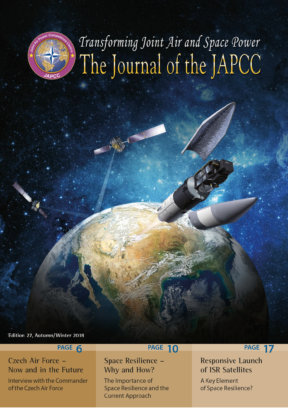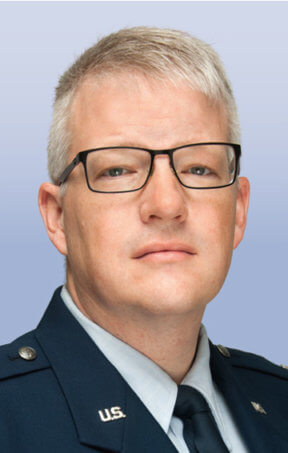‘In-flight refuelling converts the tactical fighter into a strategic, long-range participant.’
Anthony Mason, Royal Air Force Air Vice Marshal1
Predicting the future is a tenuous endeavour at best, as there are simply too many variables to take into account. The best military strategists can hope for is to look to the past to help shape the future, without falling into the same traps, or letting past biases influence the outcome. One thing for sure is that the weapon systems NATO nations employ today are going to be in service for a long time, and this means Air-to-Air Refuelling (AAR) will be required, at least for the next few decades. Commanders must define the battlespace they expect to operate in, and define those threats and the physical environment aircrew will likely face. Operators, planners, and innovators must envision ways to use current systems to counter current and future threats in new, innovative ways, while simultaneously modifying and/or developing systems that enable effectiveness in the future.
The Future Landscape
The main question analysts attempt to answer is what the operating environment will look like. They want to know whether future battles will be fought in the mountains, deserts, jungles, or urban environments. They debate if future actors will still be mainly people, or primarily unmanned or possibly autonomous systems instead. Moreover, analysts want to understand the nature of future threats. Unlike other capabilities, the physical environment does not matter to the same extent for AAR. What matters more to AAR analysts is the level to which airspace within which future warfighters have to operate is contested.
The type and sophistication of threats to today’s tanker aircraft will have more to say about how and where AAR operations take place in relation to where the receivers need to operate than the terrain below the tanker. In a permissive environment, i.e. one devoid of threats to the tanker either by airborne or ground-based systems, the tanker can come and go as it pleases. This type of environment places very few constraints on the layout of refuelling orbits and tracks, allowing the tanker to rendezvous with receivers directly over or very near their orbits areas. This extends the receiver’s loiter time in its designated orbit area due to reduced transit times from the orbit area to the tanker, and back.
On the other end of the spectrum lies a completely denied environment, i.e. one characterized by a multi-layered defence structure consisting of advanced fighter aircraft, long-range strategic Surface-to-Air Missile (SAM) systems, and overlapping medium-range SAM systems covering short-range point defence SAM systems. Assuming these systems force the basing of friendly aircraft a long distance from orbit areas or targets, planners must include AAR in the daily plan in order to extend the range and endurance of fighter, bomber, Intelligence, Surveillance, and Reconnaissance (ISR), Airborne Early Warning (AEW), and even some transport aircraft. This, coupled with the understanding that battles fought in 2035 and beyond will employ a large number of assets that have been in the inventory for several decades, a denied environment presents significant barriers to friendly success without a shift in operational paradigms. Most legacy tanker aircraft lack self-protection suites, and are anything but stealthy, meaning the denied environment almost completely excludes tanker operations close to the orbit areas of their receivers. Unfortunately, orbiting a tanker farther from the receiver’s orbit area produces two main issues. First, it means the receiver has a greater distance to travel between the tanker and orbit area, resulting in a greater need for transit fuel. Second, each additional minute spent transiting between the tanker and the orbit area is a minute the receiver is not on-station conducting its primary mission objective. This could lead to coverage gaps resulting in additional risk to mission accomplishment that must be accounted for or additional assets must be used to ensure adequate coverage. The employment of additional assets, depending on type and capabilities, could result in driving the overall tanker offload fuel requirements up. As such, military strategists must find a way to balance the success of receivers with the viability and survivability of the tanker.
Strategists also should consider that adversaries are not the only ones posing challenges to mission success. One main challenge that is not adversary-driven is limited interoperability in terms of equipment on friendly fleets. Generally, there are only two in-flight refuelling systems – boom/receptacle and probe/drogue. These two systems are not interchangeable, meaning receptacle-equipped aircraft can only refuel from a boom, while those equipped with a probe can only refuel from a drogue. Unfortunately, most tankers are equipped with only one of the two systems, not both. Some boom-equipped aircraft can add an adapter converting the boom into a drogue, but this must be completed on the ground and cannot be changed in flight. This equipment challenge means that commanders must ensure that planners are keeping a close eye not only on the total available fuel aloft, but also on the availability of systems needed to deliver that fuel.
Solutions
As has been done for generations, one can expect strategists, analysts, aircraft manufacturers, and decision-makers to integrate a small number of completely new airframes while modifying legacy airframes with new technology. Simultaneously, personnel will adapt tactics, techniques, and procedures (TTPs) to bridge the gap between old assets and new requirements. Some of these new assets that aircraft manufacturers are producing, currently or in the very new future, include multi-mission tankers and autonomous tankers and receivers, while updates to TTPs include multinational tanker formation operations.
Multi-Mission not Multi-Role. A large tanker aircraft has the capacity to perform more than just the tanker mission. With an understanding of the performance trade-offs inherent in aviation, one must take care when considering what additional capabilities a tanker could accomplish. Airbus has been developing a ‘Smart Tanker’, which could leverage the refueller’s long on-station time for Command and Control (C2) purposes.2 Other mission sets requiring long on-station times include communication relays and passive electronic information collection. The Airbus ‘Smart Tanker’ could be the first of several new multi-mission technologies.
Autonomy. Airbus is also very advanced in the development of its automated boom. Currently fitted on the Airbus A-310 aircraft, it is completely contained on the tanker and requires no modification to a receiver aircraft3. Utilizing this aircraft, Airbus conducted the first air-to-air refuelling contact with a large aircraft receiver, a Royal Australian Air Force KC-30A4. By automating the tanker’s ability to recognize a receiver (even in covert conditions) and drive the boom to a receptacle provides several benefits: reduced workload on the tanker crew, system availability to all receptacle receivers requiring no receiver modification, and the potential for reduced stress on both boom and receptacle systems, thereby reducing maintenance requirements on both aircraft.
Automating the boom is good, but a fully autonomous tanker would be even better. By eliminating the space and weight needed for crew components like pressurization, oxygen, windows, or even seats, and trading these for manoeuvrability or even stealth, an autonomous tanker could conceivably accompany a receiver into the vulnerability area. Test programs are already underway with unmanned tanker systems, such as the United States Navy’s carrier-based MQ-25 Stingray.5
Currently, the US Navy sometimes relies on its F/A-18 E/F Super Hornet as a small ‘buddy’ tanker asset. If the MQ-25 is realized, Super Hornets would be free to perform their designed mission rather than acting as ad hoc tankers. Current MQ-25 requirements are only to off-load fuel6 while conceivably accompanying a strike package to a target, but the ability for the drone tanker to receive fuel, in addition to off-loading fuel, could extend loiter time and flexibility.
Northrop Grumman provided proof of this concept – i.e. a drone receiver – during a successful 2015 trial, when its unmanned X-47B Unmanned Combat Air System (UCAS) rendezvoused with an airborne tanker, conducted AAR operations, then departed and landed safely.7 Combining the requirements of the MQ-25 and the capabilities of the X-47B into a single unmanned aircraft could provide more airborne fuel than a non-refuellable drone, thereby extending a strike package’s threat engagement time or extending the endurance of aircraft performing numerous other missions in orbit areas for long periods of time, including AEW, ISR, on-call Close Air Support (CAS), Suppression of Enemy Air Defences (SEAD), etc.
More Gas – Less Space. In order to increase the total number of pounds available for off-load, general understanding is that either the number of tankers aloft or the size of the tankers must increase. However, even if all tankers were dual-equipped – i.e. both boom and drogue – it is unlikely that only one tanker could carry enough fuel for an entire day’s requirements. Similarly, when many receivers require fuel simultaneously, more than one tanker is necessary. Current tanker planning assigns a single tanker to an orbit with four fighter-sized receivers. Fuel-flow constraints of smaller receivers limit the amount of fuel that can be passed per minute, resulting in longer times on the boom or drogue, and leading to increased time to fuel all receivers of a formation. This increased time results in some receivers in a formation departing the tanker less than full. One possible solution to this dilemma is the concept of hose-multipliers. Pairing two unmanned tankers with a larger tanker can double the amount of receivers able to refuel at a single time. However, the solution of placing more tankers in the sky becomes problematic as the size of airspace decreases. One possible solution is to shrink the space needed by creating tanker formations. Currently, very few nations use tanker formations, but those that do see their value, and are leading developments in international TTPs for such operations.
The need for more fuel in less airspace, combined with fiscal constraints and the reality that most nations do not operate large tanker fleets, means multinational tanker formations could very well characterize future operations. Furthermore, this concept could have the added benefit of increasing the diversity of airborne equipment, enabling any type of receiver the opportunity to refuel from any tanker formation. Exploiting past lessons identified, operators need to develop, evaluate, and disseminate a set of procedures prior to conflict so aircrews are familiar with them, and they are not attempting to create procedures from scratch under the pressures of combat. One nation with a large tanker fleet that operates formations regularly is the United States (US). In conjunction with the United States Air Forces Europe (USAFE) Tanker Weapons School and the Royal Air Force (RAF) Voyager Squadron, the US Air Force’s (USAF) 100th Air Refuelling Wing based at RAF Mildenhall, United Kingdom, is developing international mixed formation procedures using a crawl-walk-run approach. They have already conducted proof of concept flights between USAF KC-135 and RAF Voyager A-330 aircraft. These flights are being conducted to test the TTPs and make incremental changes with aircraft from two nations before widening the scope to include additional tanker types and nations.
Conclusion
The battlespace of 2035 may seem ethereal, but using observations of the past, strategists can make educated guesses about future realties. Due to fiscal constraints, changing threat environments, and the rapidity of changing technology, legacy aircraft will operate simultaneously with newer technologies. This ‘new normal’ will drive solution sets through multinational efforts to develop new TTPs, drive adaptation of legacy aircraft, and shift paradigms. What is clear today, is that no matter what tomorrow looks like, until engineers develop new propulsion systems that provide airframes with longer endurance and/or range, the need for passing gas from one aircraft to another will remain.












